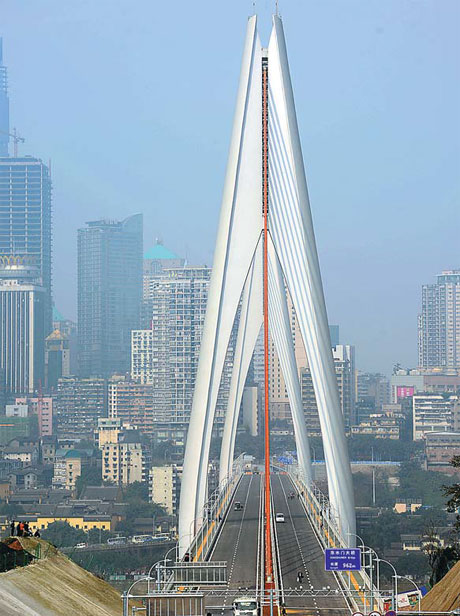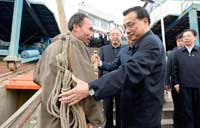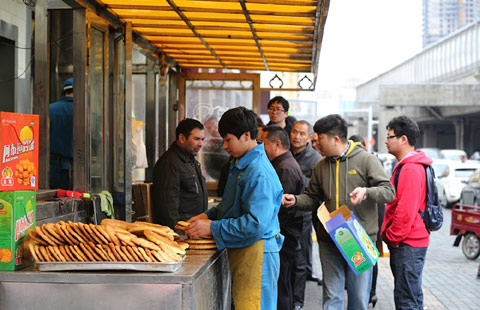Li calls for west China to welcome new firms
Updated: 2014-04-30 09:46
By Xing Zhigang and Luo Wangshu in Chongqing (China Daily)
|
|||||||||||
|
 |
| Chongqing, which opened the Dongshuimen Yangtze River Bridge on March 28, is looking to absorb environmentally friendly industries from eastern China to boost its economy. Xinhua |
Nation's plan is to move companies from eastern regions to create jobs
|
 |
| Li communicates with porters, workers in Chongqing |
The western region should "combine its advantages in labor costs with inbound capital and technologies to make transferred industries take root", he said.
The premier made the comments while visiting Chongqing Zhengtong Communications Co, a call center providing travel and information services in Wanzhou district, during a three-day visit to Chongqing, which ended on Tuesday.
Development of the western region relies on industrial restructuring, as where there is an industry there is a job, Li added.
China's eastern and coastal areas are more developed than the western region. Since the "go-west" initiative was introduced in 1998, economic development has been encouraged in western areas.
The policy is aimed at eliminating the economic gap between eastern and western China. It covers the six provinces of Gansu, Guizhou, Qinghai, Shaanxi, Sichuan and Yunnan; the five autonomous regions of Guangxi, Inner Mongolia, Ningxia, Tibet and Xinjiang; and the municipality of Chongqing.
Chongqing Zhengtong Communications Co, founded in April 2013, hired 1,500 local vocational school graduates last year, aiming to create 3,000 jobs in 2014. It plans to employ 7,500 staff members when the project is fully operational.
The company had an annual turnover of 500 million yuan ($81 million) in 2013 and is aiming to increase this to 1.2 billion yuan this year.
The call center moved from Beijing in April 2013.
Luo Shijun, deputy general manager of the company's business process outsourcing department, explained the reason for the call center moving to Wanzhou.
"On the one hand, the relocation reduces cost," Luo said, adding that the cost for human resources, management and operations has been reduced by about 30 percent. "On the other hand, Wanzhou is a resource for human capital, with the area having many vocational school graduates," Luo added.
The average labor cost in Wanzhou is about 3,000 yuan a month, 5,000 yuan less than in Beijing. Rental fees are about one fifth the rates in Beijing.
Li said the company's success is a telling example of transferring a modern service industry to the western region to generate more jobs and raise local incomes.
Che Wenhui, associate professor at the Chinese Academy of Governance, said that industrial restructuring is the basic path to take during the opening-up of the western region.
"The top priority is to transfer labor-intensive industries to the western region, which ideally will create jobs and increase the local employment rate," Che said.
Chen Xingdong, chief China economist in the Beijing office at BNP Paribas Equities (Asia), said the government would use "visible hands" to encourage regional development, but "invisible hands" from the market were the key.
Tan Yingzi in Chongqing and Zheng Yangpeng in Beijing contributed to this story.
Contact the writers at luowangshu@chinadaily.com.cn and xingzhigang@chinadaily.com.cn
Related Stories
Reviewing success and problems of China's 'Go West' campaign from a subjective point of view, pushing West China's scientific development 2014-02-14 16:45
More public infrastructure projects to "Go West" 2013-10-24 09:56
Innovation should drive reform, says Premier Li Keqiang 2013-09-18 07:48
Chongqing-Xinjiang-Russia Railway to begin regular operations 2014-03-13 09:56
Achievements of Chongqing’s Liangjiang New Area 2014-01-24 14:56
Today's Top News
Russia's FM scolds West for imposing sanctions
Obama's trip not to achieve goals
Media mogul interested in Clippers
Director enjoys overseas success
Philippine pact gives US access to air, sea bases
Hunt resumes for bodies inside ferry
Ukrainian mayor wounded by gunfire
Alibaba IPO: Could be the biggest ever
Hot Topics
Lunar probe , China growth forecasts, Emission rules get tougher, China seen through 'colored lens', International board,
Editor's Picks

|

|

|

|

|

|





